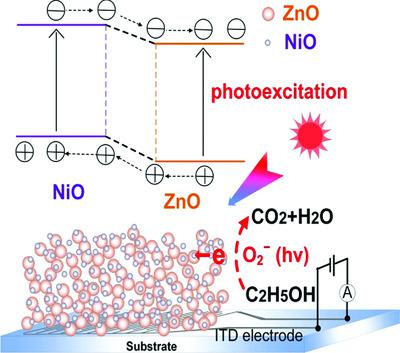当前位置:
X-MOL 学术
›
Adv. Opt. Mater.
›
论文详情
Our official English website, www.x-mol.net, welcomes your
feedback! (Note: you will need to create a separate account there.)
NiO–ZnO Nanoheterojunction Networks for Room‐Temperature Volatile Organic Compounds Sensing
Advanced Optical Materials ( IF 8.0 ) Pub Date : 2018-09-12 , DOI: 10.1002/adom.201800677 Hongjun Chen 1 , Renheng Bo 1 , Aabhash Shrestha 1 , Bobo Xin 1 , Noushin Nasiri 1, 2 , Jin Zhou 1 , Iolanda Di Bernardo 1 , Aaron Dodd 3 , Martin Saunders 3 , Josh Lipton-Duffin 4 , Thomas White 5 , Takuya Tsuzuki 6 , Antonio Tricoli 1
Advanced Optical Materials ( IF 8.0 ) Pub Date : 2018-09-12 , DOI: 10.1002/adom.201800677 Hongjun Chen 1 , Renheng Bo 1 , Aabhash Shrestha 1 , Bobo Xin 1 , Noushin Nasiri 1, 2 , Jin Zhou 1 , Iolanda Di Bernardo 1 , Aaron Dodd 3 , Martin Saunders 3 , Josh Lipton-Duffin 4 , Thomas White 5 , Takuya Tsuzuki 6 , Antonio Tricoli 1
Affiliation

|
Engineering of highly performing nanomaterials, capable of rapid detection of trace concentrations of gas molecules at room temperature, is key to the development of the next generation of miniaturized chemical sensors. Here, a highly performing nanoheterojunctions layout is presented for the rapid room‐temperature chemical sensing of volatile organic compounds down to ten particles per billion concentrations. The layout consists of a 3D network of nickel oxide–zinc oxide (NiO–ZnO) p–n semiconductors with grain size of ≈20 nm nanometers and a porosity of ≈98%. Notably, it is observed that the formation of the p–n heterojunctions by decoration of a ZnO nanoparticle networks with NiO increases the sensor response by more than four times while improving the lower limit of detection. Under solar light irradiation, the optimal NiO–ZnO nanoheterojunction networks demonstrate a strong and selective room‐temperature response to two important volatile organic compounds utilized for breath analysis, namely acetone and ethanol. Furthermore, these NiO–ZnO nanoheterojunctions show an inverse response to acetone from that observed for all others reducing gas molecules (i.e., ethanol, propane, and ethylbenzene). It is believed that these novel insights of the optoelectrochemical properties of ultraporous nanoheterojunction networks provide guidelines for the future design of low‐power solid‐state chemical sensors.
中文翻译:

NiO–ZnO纳米异质结网络,用于室温挥发性有机化合物的传感
能够在室温下快速检测痕量气体分子浓度的高性能纳米材料的工程设计,是下一代小型化学传感器发展的关键。在此,提出了一种高性能的纳米异质结布局,用于对室温下的挥发性有机化合物进行快速化学感应,检测的浓度低至十亿分之十。该布局由氧化镍-氧化锌(NiO-ZnO)p-n半导体的3D网络组成,晶粒尺寸≈20 nm纳米,孔隙率≈98%。值得注意的是,观察到通过用NiO修饰ZnO纳米颗粒网络而形成p–n异质结,可将传感器响应提高四倍以上,同时提高了检测下限。在太阳光照射下 最佳的NiO-ZnO纳米异质结网络显示出对用于呼吸分析的两种重要的挥发性有机化合物(丙酮和乙醇)的强而有选择性的室温响应。此外,与所有其他还原性气体分子(例如,乙醇,丙烷和乙苯)观察到的结果相比,这些NiO-ZnO纳米异质结显示出对丙酮的逆反应。相信这些关于超多孔纳米异质结网络的光电化学特性的新颖见解为未来低功率固态化学传感器的设计提供了指导。与所有其他还原性气体分子(如乙醇,丙烷和乙苯)相比,这些NiO-ZnO纳米异质结显示出对丙酮的逆反应。相信这些关于超多孔纳米异质结网络的光电化学特性的新颖见解为未来低功率固态化学传感器的设计提供了指导。与所有其他还原性气体分子(如乙醇,丙烷和乙苯)相比,这些NiO-ZnO纳米异质结显示出对丙酮的逆反应。相信这些关于超多孔纳米异质结网络的光电化学特性的新颖见解为未来低功率固态化学传感器的设计提供了指导。
更新日期:2018-09-12
中文翻译:

NiO–ZnO纳米异质结网络,用于室温挥发性有机化合物的传感
能够在室温下快速检测痕量气体分子浓度的高性能纳米材料的工程设计,是下一代小型化学传感器发展的关键。在此,提出了一种高性能的纳米异质结布局,用于对室温下的挥发性有机化合物进行快速化学感应,检测的浓度低至十亿分之十。该布局由氧化镍-氧化锌(NiO-ZnO)p-n半导体的3D网络组成,晶粒尺寸≈20 nm纳米,孔隙率≈98%。值得注意的是,观察到通过用NiO修饰ZnO纳米颗粒网络而形成p–n异质结,可将传感器响应提高四倍以上,同时提高了检测下限。在太阳光照射下 最佳的NiO-ZnO纳米异质结网络显示出对用于呼吸分析的两种重要的挥发性有机化合物(丙酮和乙醇)的强而有选择性的室温响应。此外,与所有其他还原性气体分子(例如,乙醇,丙烷和乙苯)观察到的结果相比,这些NiO-ZnO纳米异质结显示出对丙酮的逆反应。相信这些关于超多孔纳米异质结网络的光电化学特性的新颖见解为未来低功率固态化学传感器的设计提供了指导。与所有其他还原性气体分子(如乙醇,丙烷和乙苯)相比,这些NiO-ZnO纳米异质结显示出对丙酮的逆反应。相信这些关于超多孔纳米异质结网络的光电化学特性的新颖见解为未来低功率固态化学传感器的设计提供了指导。与所有其他还原性气体分子(如乙醇,丙烷和乙苯)相比,这些NiO-ZnO纳米异质结显示出对丙酮的逆反应。相信这些关于超多孔纳米异质结网络的光电化学特性的新颖见解为未来低功率固态化学传感器的设计提供了指导。











































 京公网安备 11010802027423号
京公网安备 11010802027423号